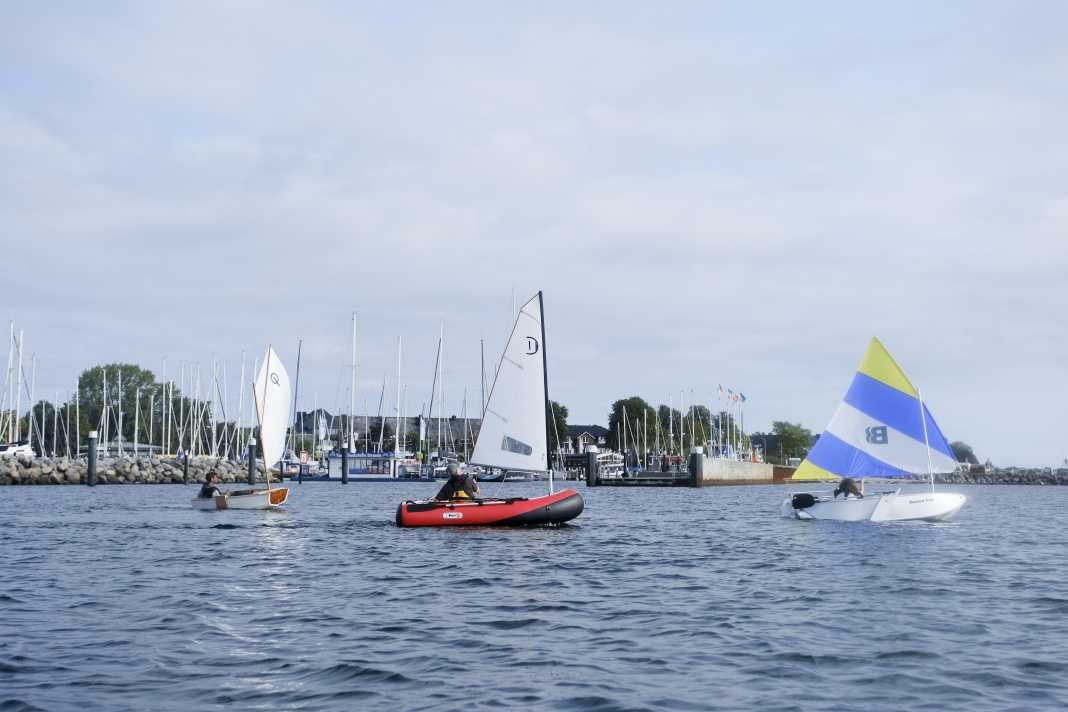





When sailing became a sport, the dinghy had long been around. Some chroniclers even assume that pleasure craft and races with the sailable dinghies of commercial and naval vessels mark this beginning. Be that as it may, it is certain that dinghies were already part of the equipment on the first yachts, just like lifebuoys and boat hooks. Not much has changed to this day. When the anchor is dropped, outboard work needs to be done or lines need to be deployed, you're lucky if you have a serviceable dinghy to hand. On the move, however, it should not interfere with the pleasure of sailing with the mother ship. If you don't want to tow your dinghy or hang it in davits, but only have limited space on deck for it, you will therefore want to look for dinghies that can be reduced in size and stowed away after use - the norm on pleasure craft. This works very well with inflatable boats, which also offer a significant weight advantage over most of their alternatives. They also stand out from them with their excellent handling characteristics under an outboard motor, are easy to tow, are low-maintenance and do not need to be fendered. For these reasons, inflatable boats dominate the dinghy fleet in marinas today. Their undeniable disadvantage is that the hulls made of coated fabric are less robust than those made of solid material. If you are looking for a dinghy that is easy to stow and can be pulled over rocks without worrying, you will want to consider alternatives - boats made of GRP or wood that can be dismantled or folded up. We have looked around the market and present six dinghies that are easy to stow. These include do-it-yourself variants that are only available in the form of plans or construction kits. And we present a self-modified version of the Optimist: it can be dismantled - and is easy to rebuild. There is another aspect that unites all the models we present: they can be sailed. Going under sail with a dinghy has gone out of fashion. The popularity of anchorages can be measured by the noise level of humming outboards. The sporting ambition to only use the engine in calm conditions often ends when the anchor drops. However, the most beautiful way of travelling with a dinghy can also be under sail. Many of the boats presented here have proven to be thoroughbred little dinghies that guarantee great sailing fun.
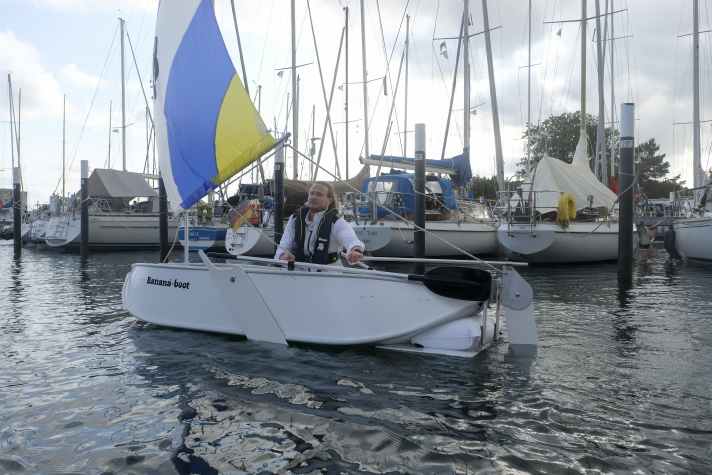
Banana boat
The Banana boat consists of four plastic strips that are movably connected to each other. The design allows the canoe-shaped dinghy to be folded flat so that it can be stored on the railing. The special plastic is very resistant and makes the boat robust and durable; there is no loss of pressure as with inflatable boats. The model tested was the 325, the number stands for the hull length in centimetres. The folded boat weighs 23 kilograms without dykes and sailing accessories and can therefore be easily moved by one person. It can be assembled alone and takes around 25 minutes with sailing accessories. The manufacturer offers equipment for propulsion with rudders, outboard motor and sails. The sail accessories consist of centreboards, rudder system, a trim plate at the stern and the rig. With a possible payload of 290 kilograms, the Banana boat offers full dinghy functionality. However, the sailing characteristics are modest: The small centreboards can do little to counter drift, and the cloth, which is modelled on a lateen sail, generates little propulsion, especially downwind. It was therefore not possible to cross in confined spaces, as the ship hardly picked up any speed between the tacks and the bow was very difficult to get through the wind. In addition, even light gusts cause the boat to twist so much that the bow and mast are pushed to leeward while the stern is still horizontal in the water. The oars then provide a remedy to get out of the pit lane and the harbour. The Banana boat is easy to row. When the yacht was being towed, it wobbled around a little in the wake. But it can be folded up to save space and stowed at the railing. The tested version with a length of 3.25 metres, sails and oars is not exactly cheap at 3,790 euros. On the plus side, however, the manufacturer offers a generous 15-year warranty.

DinghyGo 3
The DinghyGo is an inflatable boat with a fixed transom, to which an outboard motor can be attached and in which there is a bilge hatch that keeps the boat dry even when being towed. The highlight is the functional sailing equipment and a centreboard box in the middle, which can be attached with Velcro under the rudder bulge if required. The rudder, centreboard and the unstayed mast with the sail pushed over are installed in no time at all. All it takes is 15 minutes to turn the two panniers into a boat that is ready to sail. The DinghyGo can be motorised up to 6 hp, is easy to row and tow and is therefore comparable to conventional inflatable boats of this size. Its strength, however, is its sailing equipment. In just a few simple steps, a real small dinghy is created, which is uncomplicated and manoeuvrable, extremely stable in the water and sails extremely well on all courses. The Opti was only recognisably superior on the cross. The rig and equipment fulfil dinghy rather than dinghy standards. The centreboard and folding rudder are profiled, the flared sail is well cut and is held in shape by three battens. It is simply slipped over the mast and attached to the boom at the neck and horn with sewn-on Velcro lashings. The lower leech can be stretched, otherwise there is only the sheet. Many good ideas have been realised in the details, such as the two aft handles on the inside so that one person can hold both. The dinghies have been manufactured using a weight-optimised sandwich process and the middle one can be removed, which provides more space if the DinghyGo is to be used as a tender under motor. The boat is available in three sizes. The 2.75 metre version we sailed is no longer manufactured. A comparable version with a 2.80 metre hull is available. The one metre longer DinghyGo Orca 375 costs 5,015 euros.
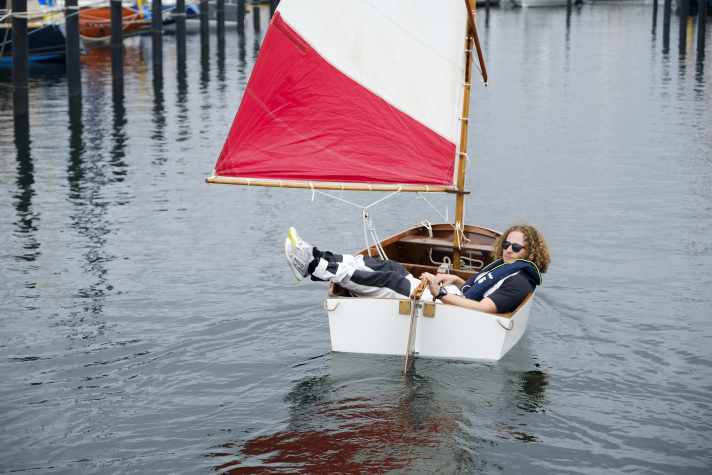
Optimist
The Optimist is not only a popular entry-level dinghy for children and young people, but is also used as a dinghy. It is suitable thanks to its stable position in the water, which allows safe manoeuvring even with adult passengers. The Opti is also available cheaply on the second-hand market; spare parts such as the rudder system, centreboard or rig are also easy and inexpensive to obtain. Optimists made of plywood can also be modified for a smaller pack size: two bulkheads were glued in front of the centreboard box with a 5 millimetre gap and then the front section between the new bulkheads was sawn off. This allows the bow to be stored in the aft section, and instead of 2.30 metres, the box to be stowed is now only 1.45 metres long. The two parts are put together with four screws, the mast is erected and the sailing dinghy is ready for use. It takes 10 minutes. The Opti costs around 500 euros. The conversion takes about 40 hours and costs around 400 euros. In addition to plywood and resin, this price also includes paint for the refurbishment. The conversion to a nesting dinghy has no effect on the sailing characteristics: the Opti sails excellently, is easy to steer and doesn't drift much thanks to its central centreboard. It goes quickly through the wind, and crossing the pit lane in the harbour was no problem. The additional bulkheads only reduce the usable space on board. However, there is room for two people, albeit a little tight. An outboard motor (3 hp) can also be used for propulsion, although this is not ideal: the Opti is then very stern-heavy and sucks in aft. It can be used as a dinghy, but more as a sailing pleasure craft than as a pure means of transport. For this use, it is advisable to attach a wieling made of thick rope all round to protect the yacht from scratches. The Opti can also be towed well, in which case a tarpaulin is recommended.
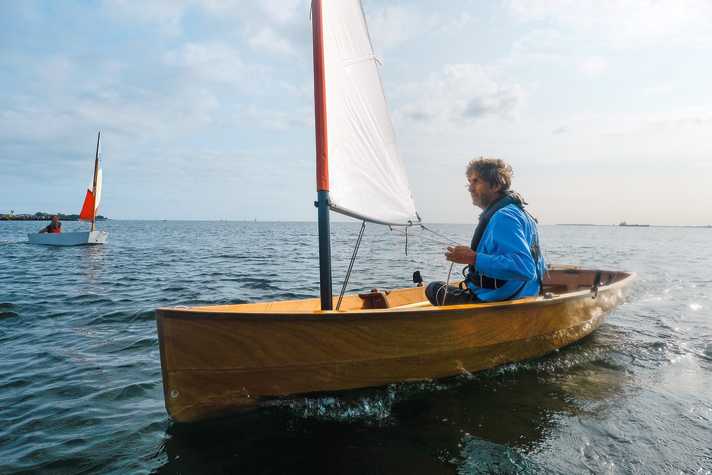
PT 11
Anyone who sees them wants them. Anyone who sails her doesn't want to get off. But anyone who takes a closer look at the eleven-foot-long PT 11 from modular boat manufacturer Chesapeake Light Craft also knows that it is a comparatively laborious journey before the fun begins. Unless, of course, the construction is already included. In that case, the vehicle developed by the supplier as a dinghy should be included in the shortlist. However, it only takes a few minutes to assemble a boat from the two finished halves and the sail kit stowed in a bag, even without any previous knowledge. The demonstration model was built at von der Linden strictly according to plan using the West System construction method. The result is a gem made from the highest quality materials, and the accessories are also first class. The centreboard and rudder are profiled, the mast and boom are made of carbon fibre. The two hull sections are lightweight, fit together perfectly and can be screwed together in no time at all using solid knobs. Once the centreboard, rudder and unstayed mast have been fitted, the boat is ready for use. In the water, despite its conventional appearance, the PT 11 is more reminiscent of a modern one-man dinghy than a typical yacht dinghy. As a lightweight and not exactly wide in the waterline area, it is only really stable under sail. This is both a strength and a weakness. The well-engineered design makes for great sailing fun. Gliding can be achieved with a little wind. However, the PT 11 is not the first choice if the family wants to take barbecue equipment ashore from the anchored yacht. Parents and two children will find room on board, but will have to get on and off very carefully to avoid capsizing. When towing, the boat is extremely directionally stable, but in waves the lightweight hull bounces strongly and jerks accordingly. Rowing with the PT 11 is great fun due to its design. The narrow boat is quickly brought up to speed with long, light wooden oars. The kit can be ordered in the USA from Chesapeake Light Craft: The parts for the hull cost 3,995, the sail components 1,935 dollars.

Sailbird
The inventor of the Banana boat, Nicolaas F. Tjebbes, has brought a clever and functional patent onto the market with Sailbird. Inflatable boats with a fixed transom and fixed floor (wooden slats, plywood, aluminium, high-pressure and fixed hull floors) can be used under sail. To prepare, a base plate with mast base must be firmly attached to the bottom of the boat. Then glue two rudder dowel fittings to the hull, to which the spar for the centreboards will later be attached. The rudder fittings are also screwed to the transom. After this preparation, the boat can be rigged. In our comparison, this took half an hour and therefore the longest. Sailbird is also ahead in terms of the number of individual parts. But that is the price for the very compact stowage dimensions. And all the parts are of high quality, well made and fit perfectly. The unstayed mast, the sprit and the boom are assembled from individual parts that are held together with internal rubber cords. Once all the accessories are in place, the lateen sail can be set. It is available in two sizes: the manufacturer recommends the 3.4 square metre sail for inflatable boats from 2.20 to 2.50 metres, and a 4.2 square metre sail for boats from 2.50 to 3.90 metres. The construction sits very firmly on the boat. The centreboards have a large surface area, as does the heavily pre-balanced rudder blade. Once everything has been fitted, the dimensions of all the fittings make them easy to operate even with clammy fingers. The 2.30 metre boat on show was very easy to sail with Sailbird. It made good progress on all courses, even in somewhat choppy waves. It is easy to manoeuvre and extremely manoeuvrable. In terms of speed, most of the other boats had an advantage in light winds. However, when it got a bit rough, Sailbird was able to keep up with the small 2.30 metre inflatable boat. The Sailbird set for inflatable boats from 2.20 to 2.50 metres in length costs 1,149 euros.
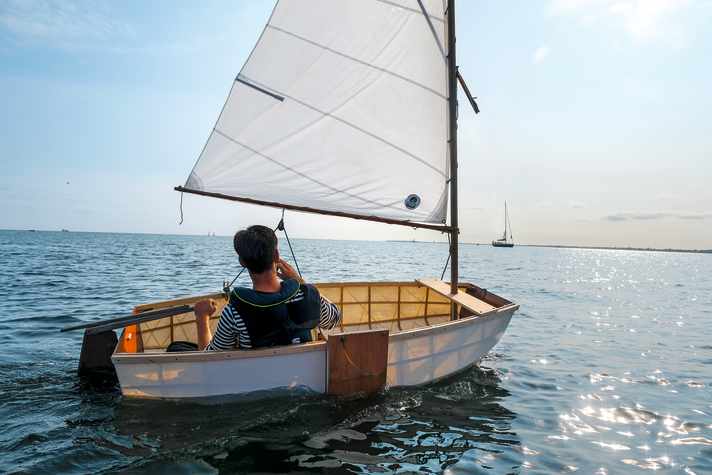
Stasha
The Stasha is not available to buy ready-made, but a construction manual is sold. The two halves of the nesting thingy are built as a skeleton from mouldings and covered with a special Dacron. This is then heated with an iron to make it so tight that small creases disappear and the construction floats stably on the water after painting. The strength is reinforced by net-like Kevlar threads that stiffen the covered wooden construction. The folding centreboard is also sawn out in-house and an Opti rudder system can be used for steering. The same applies to the sails, which also come from the Optimist. The manufacturer specifies a construction time of 50 hours. This time is possibly realistic if the construction project is tackled in a concentrated manner over several consecutive days. However, if it is given one or two hours of attention every evening, as was the case here, then a lot of time is spent studying the construction plan and comparing the current status each time. In total, it took about 75 hours. Once the rather long construction phase has been completed, you only have to reckon with around 10 minutes of assembly time when the boat is ready for use - a very good value. The construction plan costs 40 euros, the materials around 700 euros. This makes the Stasha, alongside the Opti, one of the cheapest sailable dinghies in the comparison. Weighing 10 kilograms without sails, the boat is extremely light and appears quite fragile. However, during the test and also on subsequent outings by the builder and YACHT editor Lasse Johannsen, everything held up; even though the construction sometimes bounced precariously, nothing broke or tore. The sailing characteristics are good, the Stasha picks up speed quickly and manoeuvres agilely. Sailing up the narrow pit lane was no problem, the small boat handled the wind very well without losing much speed.

